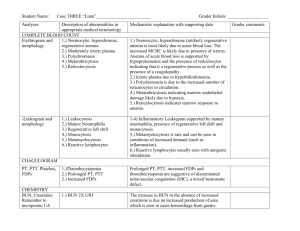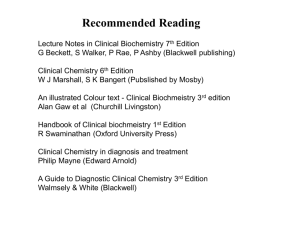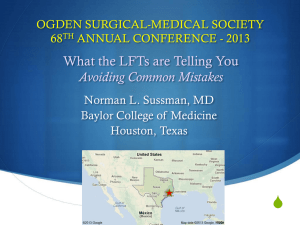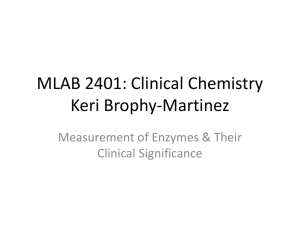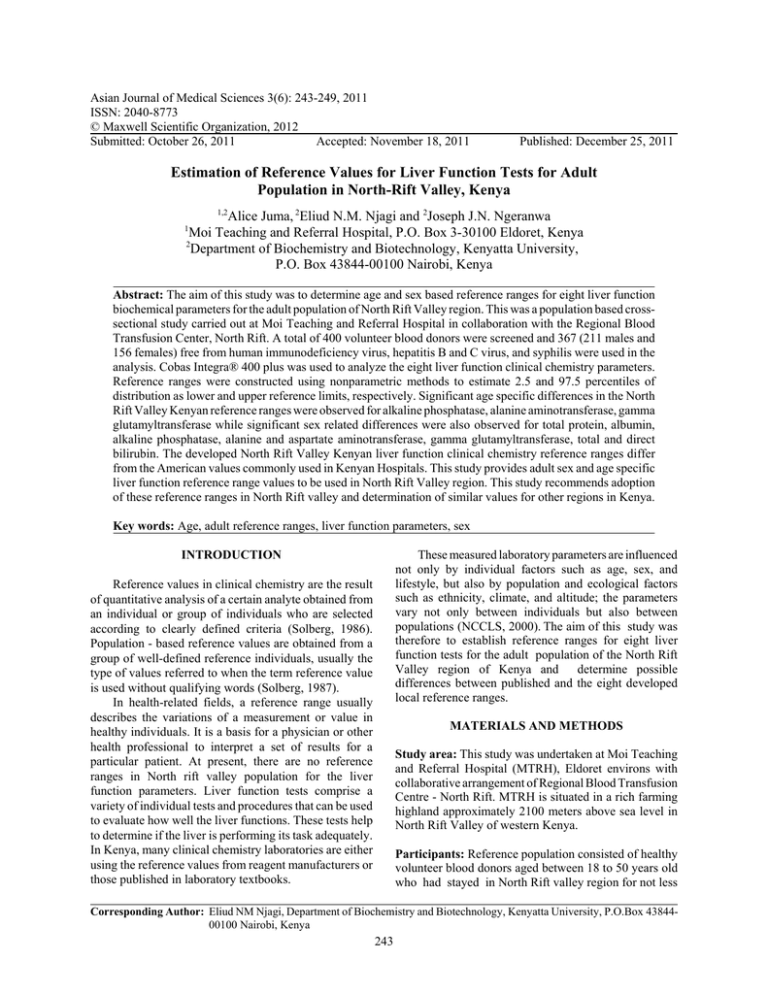
Asian Journal of Medical Sciences 3(6): 243-249, 2011
ISSN: 2040-8773
© Maxwell Scientific Organization, 2012
Submitted: October 26, 2011
Accepted: November 18, 2011
Published: December 25, 2011
Estimation of Reference Values for Liver Function Tests for Adult
Population in North-Rift Valley, Kenya
1,2
Alice Juma, 2Eliud N.M. Njagi and 2Joseph J.N. Ngeranwa
1
Moi Teaching and Referral Hospital, P.O. Box 3-30100 Eldoret, Kenya
2
Department of Biochemistry and Biotechnology, Kenyatta University,
P.O. Box 43844-00100 Nairobi, Kenya
Abstract: The aim of this study was to determine age and sex based reference ranges for eight liver function
biochemical parameters for the adult population of North Rift Valley region. This was a population based crosssectional study carried out at Moi Teaching and Referral Hospital in collaboration with the Regional Blood
Transfusion Center, North Rift. A total of 400 volunteer blood donors were screened and 367 (211 males and
156 females) free from human immunodeficiency virus, hepatitis B and C virus, and syphilis were used in the
analysis. Cobas Integra® 400 plus was used to analyze the eight liver function clinical chemistry parameters.
Reference ranges were constructed using nonparametric methods to estimate 2.5 and 97.5 percentiles of
distribution as lower and upper reference limits, respectively. Significant age specific differences in the North
Rift Valley Kenyan reference ranges were observed for alkaline phosphatase, alanine aminotransferase, gamma
glutamyltransferase while significant sex related differences were also observed for total protein, albumin,
alkaline phosphatase, alanine and aspartate aminotransferase, gamma glutamyltransferase, total and direct
bilirubin. The developed North Rift Valley Kenyan liver function clinical chemistry reference ranges differ
from the American values commonly used in Kenyan Hospitals. This study provides adult sex and age specific
liver function reference range values to be used in North Rift Valley region. This study recommends adoption
of these reference ranges in North Rift valley and determination of similar values for other regions in Kenya.
Key words: Age, adult reference ranges, liver function parameters, sex
These measured laboratory parameters are influenced
not only by individual factors such as age, sex, and
lifestyle, but also by population and ecological factors
such as ethnicity, climate, and altitude; the parameters
vary not only between individuals but also between
populations (NCCLS, 2000). The aim of this study was
therefore to establish reference ranges for eight liver
function tests for the adult population of the North Rift
Valley region of Kenya and determine possible
differences between published and the eight developed
local reference ranges.
INTRODUCTION
Reference values in clinical chemistry are the result
of quantitative analysis of a certain analyte obtained from
an individual or group of individuals who are selected
according to clearly defined criteria (Solberg, 1986).
Population - based reference values are obtained from a
group of well-defined reference individuals, usually the
type of values referred to when the term reference value
is used without qualifying words (Solberg, 1987).
In health-related fields, a reference range usually
describes the variations of a measurement or value in
healthy individuals. It is a basis for a physician or other
health professional to interpret a set of results for a
particular patient. At present, there are no reference
ranges in North rift valley population for the liver
function parameters. Liver function tests comprise a
variety of individual tests and procedures that can be used
to evaluate how well the liver functions. These tests help
to determine if the liver is performing its task adequately.
In Kenya, many clinical chemistry laboratories are either
using the reference values from reagent manufacturers or
those published in laboratory textbooks.
MATERIALS AND METHODS
Study area: This study was undertaken at Moi Teaching
and Referral Hospital (MTRH), Eldoret environs with
collaborative arrangement of Regional Blood Transfusion
Centre - North Rift. MTRH is situated in a rich farming
highland approximately 2100 meters above sea level in
North Rift Valley of western Kenya.
Participants: Reference population consisted of healthy
volunteer blood donors aged between 18 to 50 years old
who had stayed in North Rift valley region for not less
Corresponding Author: Eliud NM Njagi, Department of Biochemistry and Biotechnology, Kenyatta University, P.O.Box 4384400100 Nairobi, Kenya
243
Asian J. Med. Sci., 3(6): 243-249, 2011
than six months. Donors came from different parts of
North Rift valley region and those who gave written
informed consent for this study were interviewed through
a questionnaire. Those who did not meet the inclusion
criteria were excluded from the study.
using vacutainer needles and plain vacutainer tubes. Once
the specimens were acquired, they were labeled with the
donor and study numbers. After bleeding each participant,
about five milliliters of blood from the blood bag was
collected and used to screen for human immunodeficiency
virus (HIV), Hepatitis B surface antigen (HBsAg),
Hepatitis C virus (HCV), Syphilis (VDRL) and
pregnancy.
Ethical consideration: Ethical approval was obtained
from Moi Teaching and Referral Hospital and Moi
University Review and Ethical Committee and permission
to use the regional blood donor facility granted by the
Ministry of Health, Kenya.
Specimen transportation, processing and storage:
Specimens were transported from the donation centre to
the processing laboratory in ice packed cool boxes within
one hour. Once clotted, the blood specimens were
centrifuged at 3000 revolutions per minute for two
minutes and serum separated immediately into labeled
cryovials in duplicate. Serum specimens were then stored
at -70oC awaiting laboratory analysis at AMPATH clinical
laboratory at MTRH.
Inclusion and exclusion criteria: Healthy males and
females between 18 and 50 years who had stayed in North
Rift Valley region of Kenya for not less than six months
were included in the study. Donor serum samples from
people on any form of medication, oral contraceptives,
smokers and those with chronic diseases such as
tuberculosis, diabetes mellitus, hypertension, chronic
renal failure were excluded from the study. All donor
serum samples which tested positive for HIV antibody,
Hepatitis B surface antigen, Hepatitis C antibody and
Syphilis were excluded from the study data set. Also
excluded were donor serum samples from pregnant
women and male and female blood donors who did not
consent to participate in the study.
Initial screening for anti HIV-1 antibody was
conducted using Genetic Systems rLAV ELISA (BioRad
Laboratories, Redmond, WA). Reactive samples were
repeated in duplicates using Vironostika HIV-1
Microelisa Systems (Organon Teknika, Durham, North
Carolina). Samples repeatedly reactive by both ELISAs
were tested using Genetic Systems Confirmatory Assay
3.0 (BioRad Laboratories, Redmond, WA). Screening for
Hepatitis B surface antigen (HBsAg) was performed using
the Genetic Systems HBsAg EIA 3.0 (BioRad
Laboratories, Redmond, WA). Repeatedly reactive
samples were confirmed using the Genetic System
Confirmatory Assay 3.0 (BioRad Laboratories, Redmond,
WA). Screening for anti-Hepatitis C antibody was
performed using the Ortho HCV version 3.0 ELISA Tests
System. Repeatedly reactive samples were tested in the
Chiron RIBA HCV 3.0 SIA (Chiron Corporation,
Emeryville, CA). Serum pregnancy testing was performed
on all females using Wampole PreVue HCG cassettes
(Wampole Laboratories, Inc Dist., Princeton, NJ).
Syphilis testing was performed using the Wampole
Laboratories Impact RPR (Wampole Laboratories,
Princeton, NJ, USA).
Laboratory analysis: Eight liver function tests were
determined on the sera specimens: total proteins (TP),
albumin (ALB), alanine aminotransferase (ALT),
aspartate aminotransferase (AST), alkaline phosphatase
(ALP), Gamma-glutamyl transferase (GGT), total
bilirubin (BIL-T) and direct bilirubin (BIL-D). All the
assays were performed based on the standard operating
procedures (SOPs) written and maintained in the
AMPATH modular laboratory using Cobas Integra® 400
plus automatic Chemistry Analyzer (Roche Diagnostics,
Mannheim, Germany).
Calibration of tests: Calibrator for automated systems
(C.f.a.s) was used. The system performed calibrations
automatically.
Quality Assurance (QA)/ Quality Control (QC): To
ensure accuracy and precision of the test results, all
preanalytical, analytical and post analytical precautions
were taken into consideration. Internal QC materials from
Roche diagnostics; Precinorm and Precipath which were
run daily and external QC materials from American
Proficiency Institute (API) which monitors the
performance and participation of MTRH and AMPATH
laboratories were run twice during the analytical period
according to the manufacturers’ instructions and QC
protocols. The system performed quality controls
automatically according to the specifications in the test
definition (Ohmann, 1997).
Data management and statistical analysis: Data were
double entered into a Microsoft Excel database,
compared, and corrected for data entry errors then
imported into Statistical Package for Social Sciences
(SPSS). The data was visually inspected for extreme
values and ten values for single parameters that appeared
physiologically impossible removed. Outliers in the
remaining data were identified using Box plots, a
Specimen collection: Blood from suitable blood donors
was the specimen of choice and collection was done
during the day between the months of August and
December 2007. Three hundred milliliters of blood was
allowed to flow into the blood bag to clear any
anticoagulant along the wall of the pilot tube. Ten
millilitres of blood was then sampled from the sampling
pot along the pilot line of the blood bag during donation
244
Asian J. Med. Sci., 3(6): 243-249, 2011
procedure proposed by Horns and Pesce (2003). The first
quartile (Q25), the median (Q.50) and third quartile (Q.75)
were calculated, that is, the interquartile range (IQR) by
subtracting the first quartile from the third quartile (Q.75 Q.25). Any data observation which lay more than 1.5 ×
IQR lower than the first quartile or 1.5 × IQR higher than
the third quartile was considered an outlier and manually
deleted from the data. The above exclusions and missing
results for some parameters led to different sample sizes
for each parameter.
Since more than half of the measured parameters did
not follow a Gaussian probability curve according to
Kolmogorov-Smirnov and Shapiro-Wilk tests for
normality, non parametric statistical methods were
therefore used as per the CLSI guideline (NCCLS, 2000).
Non-parametrically, reference ranges, means and
medians were directly obtained from the analyzed data
separately for both males and females at 95% confidence
limit (2.5th and 97.5th percentiles) (Horns and Pesce,
2003). P-values for the difference between male and
female participants were estimated using the MannWhitney test where p<0.05 were considered significantly
different. Comparison of reference ranges for different
age groups for each sex was by means comparison using
One-Way-ANOVA and Dunnetts Multiple Comparisons
test since all age categories did not have a minimum
sample size of 120 required by CLSI (NCCLS, 2000);
p<0.05 was considered significantly different.
values for each parameter which were all above the
minimum sample size (N = 120) suggested by CLSI
(NCCLS, 2000). All the liver function tests (LFTs) (TP,
ALB, ALT, AST, ALP, GGT, BIL-D and BIL-T) showed
significant sex differences (p<0.05).
Reference range values among different age groups in
healthy adult North rift valley Kenyan population: The
different age groups were categorized as: Category 1 (1828 years), Category 2 (29-39 years), and Category 3 (4050 years). Reference range differences between males and
females for the measured analytes were estimated by
comparing the mean of each age category using OneWay-ANOVA and Dunnetts Multiple Comparisons test;
p-values less than 0.05 were considered statistically
significant.
Table 2 shows analytes that comprise liver function
tests. In age category 1, all the measured analytes showed
significant sex differences as indicated by p<0.05. In age
category 2, analytes ALB, BIL-D, ALT and AST showed
significant sex differences as indicated by p<0.05. In age
category 3, analytes ALB, BIL-D, AST, and GGT showed
significant sex differences as indicated by p<0.05. Males
had greater reference values for all the measured analytes
in all age categories compared to females. Significant
differences between age groups 1 and 2 shown by
superscript a (a) within females for liver function tests
were seen with ALT and GGT while within males they
were seen in ALP and ALT. Difference between group 1
and 3 was only observed with males for GGT among all
the liver function tests as shown by superscript b (b).
RESULTS
Establishment of reference ranges for adult males and
females: Out of the 400 participants recruited for the
study, only 367 were involved in the study; 211 males and
156 females. Of those whose data were excluded,
11(33%) were HIV positive, 6(18%) HBsAg positive,
5(15%) HCV positive, 2(6%) VDRL positive, 2(6%)
were lipeamic, 3(9%) icteric, and 4(12%) were
hemolyzed. Reference ranges for eight liver function
biochemical parameters were established for males and
females with an age range of 18 to 50 years with median
age of 25 and 27 for males and for females, respectively.
The reference values were constructed using 2.5th and
97.5th percentiles as lower and upper limits at 95%
confidence interval in accordance with CLSI (NCCLS,
2000) guideline for determining reference intervals. The
medians for males and females were statistically
compared using Mann-Whitney test. p<0.05 was
considered statistically different.
Table 1 shows combined or sex specific reference
ranges for each parameter based on the p-values for the
difference between male and female participants. The
table also indicate the number of combined and sex
specific participants used for determining the reference
Comparison of North-Rift valley population reference
values of the measured analytes with those found in
literature: Table 3 compares reference range values for
liver function tests with the literature values. Comparisons
were based on the lower and upper reference limits and
interval values of each analyte. TP values for north rift
were greater than those for all the comparison sites and all
the studies showed insignificant sex difference except in
Uganda. ALB values for North Rift were in agreement
with the Ugandan one but slightly greater than for other
areas. The ALP values for this study were higher than
those for Roche with lower limits in better agreement with
those from other areas while the upper limit was lower
than that from other sites. Male ALT values were
comparable with those from Mbeya and Kampala but
were lower than those from Kericho, compared to Roche;
the North Rift ALT values were higher while female
upper limit values for North Rift were lower than those
from all the others. North Rift AST values were in better
agreement with the Kericho ones. Bilirubin values for the
current study were higher than for Roche and Kuwait but
almost twice those from other literature areas. Upper GGT
limits compared well with the Ugandan values, were
higher than those for Roche but were markedly lower than
245
Asian J. Med. Sci., 3(6): 243-249, 2011
Table 1: The established reference ranges for TP, ALB, ALP, ALT, AST, GGT, BILD and BIL-T for male and female adults from North rift valley
region-Kenya
Percentiles
Difference between M & F
-----------------------------------------------------------------th
th
Analyte (unit)
Sex
N
Median
2.5
97.5
Reference value IV
z-value
Sig*
TP (g/L)
M&F
361
78
67
92
67-92
25
-0.436
0.003*
F
207
79
66
89
66-89
23
M
154
79
67
93
67-93
26
ALB (g/L)
M&F
364
44
38
50
38-50
12
-5.52
<0.001*
F
208
43
38
48
38-48
10
M
156
45
38
51
38-51
13
ALP (U/L)
M&F
348
81
43
143
43-143
100
-4.913
<0.001*
F
148
74
43
126
43-126
83
M
200
87
45
147
45-147
83
ALT (U/L)
M&F
361
15
7
39
7-39
32
-6.502
<0.001*
F
153
13
6
27
6-27
21
M
207
17
9
42
9-42
33
AST (U/L)
M&F
361
22
13
44
13-44
31
-9.502
<0.001*
F
152
19
12
33
12-33
21
M
209
25
16
47
16-47
31
GGT (U/L)
M&F
353
19
7
66
7-66
59
-0.745
<0.001*
F
149
17
7
49
7-49
42
M
204
20
6
69
6-69
63
BIL-D (:mol/L)
M&F
347
1.7
0.2
4.8
0.2-4.8
4.6
-5.507
<0.001*
F
146
1.4
0.2
3.7
0.2-3.7
3.5
M
201
2.0
0.5
4.9
0.5-4.9
4.4
BIL-T (:mol/L)
M&F
357
9.8
4.5
28.0
4.5-28.0
23.5
-5.439
<0.001*
F
156
8.3
3.4
27.0
3.4-27.0
23.6
M
201
8.3
4.9
29.7
4.9-29.7
24.8
Results are expressed as median value of the measured analyte for the number of subjects shown in the column labeled N; *: represents significant
sex difference where p<0.05 by Mann-Whitney test; Sig: significance; M: male; F: female; IV: Interval Value
Table 2: Comparison of reference ranges for male and female in different age groups for TP, ALB, BIL-D, BIL-T, ALP, ALT, AST and GGT.
Analyte (Unit)
Sex
N
Category I 18-28 years
N
Category II 29-39 years
N
Category III 40-50 years
TP (g/L)
M
134
79.00±6.55*
50
80.08±5.71
23
80.08±6.00
F
89
76.84±5.74
44
78.07±5.04
21
77.56±4.61
ALB (g/L)
M
135
44.43±3.17*
50
45.61±3.06*
23
44.76±2.65*
F
91
42.96±3.14
44
43.10±2.22
21
42.64±2.21
BIL-D (:mol/L)
M
127
2.28±1.28*
51
2.05±1.12*
23
2.14±1.19*
F
84
1.60±0.89
42
1.46±0.76
20
1.37±0.91
BIL-T (:mol/L)
M
129
13.15±6.47*
50
12.03±5.20
22
12.46±6.13
F
91
10.06±5.17
44
11.68±16.70
21
9.55±6.27
ALP (U/L)
M
127
92.93±25.69*
51
82.26±22.14a
22
83.20±20.63
F
86
75.45±21.39
44
76.70±22.41
21
80.20±23.49
a
ALT (U/L)
M
133
17.78±7.83*
51
21.71±9.55 *
23
18.91±6.69
a
F
89
12.11±4.40
44
16.55±5.67
20
15.44±6.76
AST (U/L)
M
133
26.42±6.74*
53
27.31±10.38*
23
23.97±7.42*
F
88
19.77±4.62
43
20.56±4.65
18
18.70±4.70
GGT (U/L)
M
133
22.02±13.52*
49
28.78±18.53
22
33.95±18.36b*
F
89
16.69±7.51
41
25.51±14.34a
19
23.05±11.15
Results are expressed as Mean ± standard deviation (SD) of the number of subjects shown in columns labeled N; *: significant sex difference in each
age category where p<0.05 by t-test: a: significant specific sex difference between age category 1 and 2 where p<0.05 by One-Way ANOVA and
Dunnetts Multiple Comparison test; b: represents significant specific sex difference between age category 1 and 3 where p<0.05 by One-Way ANOVA
and Dunnetts Multiple Comparison test
nonparametric estimates required for 95% reference
interval determination as recommended by CLSI
(NCCLS, 2000). The lower proportion of females is likely
due to physiological factors such as pregnancy, lactation
and menstruation, therefore less frequent participation in
blood donation. The rigorous screening process employed
by the blood bank presumably resulted in blood collection
from overall healthy adults. The results for reference
values for each parameter under study were obtained
using similar analytical methods and unit of measure as
those in the literature. Emphasis was laid on external and
internal quality control methods which ensured accuracy
and precision (Gahutu and Wane, 2006).
the Tanzanian limit. During the entire analytical period,
everyday control value result and the standard deviation
(SD) from the control target value were noted (Table 4).
All the daily QC runs were within ±2SD from the target
values.
DISCUSSION
Reference values for adult males and females in North
Rift Valley region Kenyans have not previously been
established. Although the number of males (211) was
more than those of females (156), each group exceeded
the minimum of 120 participants per subgroup for
246
Asian J. Med. Sci., 3(6): 243-249, 2011
Table 3: Comparison of established reference values for TP, ALB, ALP, ALT, AST, GGT, BIL-D and BIL-T for North-Rift valley population with
those in literature
Analyte (unit)
Sex
NorthRift, Kenya Roche, America Kericho, Kenya
Mbeya, Tanzania
Kampala, Uganda
Kuwait
TP (g/L)
M&F
67-92
64-83
66.3-85.5
66-89*
64-79
M
65-89
F
68-90
ALB (g/L)
M&F
38-50*
35-50
37-49*
37-50
38-53*
35-47
M
38-51
35.8-48.1
39-54
F
38-48
34.4-47.5
37-52
ALP (U/L)
M&F
44-151
40-87
M
45-147
40-129
45-170
42-159
F
43-126
35-104
45-155
47-160
ALT (U/L)
M&F
10-49
M
9-42
0- 41
11-54
7-45
7-43
F
6-27
0- 32
9-47
9 -55
5-39
AST (U/L)
M&F
14-38
M
16-47
0- 38
15-45
15 -53
13-36
F
12-33
0- 31
13-38
14-35
11-29
GGT (U/L)
M&F
8.5-69*
M
6-69
8-61
9-121
9-71
F
7-49
5-36
7-52
8-41
0.2-4.8*
0.3-4.0
1.1-8.8
0.7-8.2
0.3-6.8
BIL-D (:mol/L) M&F
M
0.5-4.9
1.7-8.6
F
0.2-3.7
0-6.84
3.4-27.0*
0- 17.1
4.9-39.9
5.2-41
6.8-42.8
4-17
BIL-T (:mol/L) M&F
M
4.9-29.7
6.8 -44.5
F
3.4-27.0
5.1-32.5
*: significant sex difference p<0.05 but combined values indicated for comparison with other studies; Kericho: reference values by Kibaya et al.
(2008); Mbeya: reference values by Saathoff et al. (2008); Kampala: reference values by Eller et al. (2008); Kuwait: values by Olusi and Al-Awadhi
(2002); Roche: values by Roche diagnostics (2005)
Table 4: The quality control (QC) report for TP, ALB, ALP, ALT, AST,BIL-D and BIL-T under study
Assigned QC report
Study QC report
-----------------------------------------------------------------------------------------------------------------Analyte (unit)
Qctype
Mean
SD
%CV
Mean
SD
% CV
TP (g/L)
PPU
49.7
2.0
4.02
48.6
1.2
2.52
PNU
67.0
2.7
4.03
66.5
1.6
2.35
ALB (g/L)
PPU
31.3
1.90
6.07
29.95
1.06
3.60
PNU
48.8
2.90
5.94
48.85
1.75
3.73
ALP (U/L)
PPU
228
14.0
6.14
226.8
5.1
2.23
PNU
83.4
5.0
6.00
83.8
2.6
3.16
ALT (U/L)
PPU
137
8.0
5.84
143.1
2.5
1.75
PNU
48.4
2.9
5.99
49.3
2.0
4.09
AST (U/L)
PPU
142
9.0
6.34
145.5
1.9
1.32
PNU
43
2.6
6.05
44.8
1.3
2.99
GGT (U/L)
PPU
234
14
6.0
228.4
15
6.6
PNU
47.7
2.9
6.1
47.1
3.1
6.6
PPU
36.60
2.90
7.92
36.32
0.75
2.06
BIL-D (:mol/L)
PNU
8.55
0.68
7.95
8.52
0.29
3.35
PPU
97.3
5.8
5.96
93.5
3.1
3.27
BIL-T (:mol/L)
PNU
22.2
1.3
5.86
21.7
0.9
4.26
The significantly higher values of the reference
ranges for ALP, ALT, AST, GGT, TP, ALB, BIL-D and
BIL-T in males compared to females indicates sex
differences in these clinical chemistry parameters. Sex
differences in AST, ALT, and ALP have been known to
exist due to differences in muscle mass which affects AST
and ALT and bone mass which influences ALP. Similar
findings have been reported in black populations of
Kampala, Uganda; Kericho, Kenya; Mbeya, Tanzania;
Rwanda and white USA populations (Roche diagnostics,
2005; Gahutu and Wane, 2006; Saathoff et al., 2008; Eller
et al., 2008; Kibaya et al., 2008). The differences by sex
noted for GGT could be due to extra production from the
prostate gland in males as compared to females who have
no prostate gland, a result that agrees with those reported
in other East African states (Saathoff et al., 2008; Eller
et al., 2008). Sex differences in the BIL-T and BIL-D
values could be partly due to influence of sex hormones.
These findings are in agreement with those of similar
studies done in Uganda (Eller et al., 2008). Manolio et al.
(1992) reported higher reference range values for ALT,
GGT, ALP and BIL-T in both white and black males than
for black and white females, respectively.
The significant sex differences in the reference range
values for TP and ALB could be attributed to the sample
size; however, this difference may not have clinical
247
Asian J. Med. Sci., 3(6): 243-249, 2011
ACKNOWLEDGMENT
significance. The sex difference in the reference range
values for serum TP observed in this study are in contrast
to that reported for the American population where males
and females have common reference range values but
agrees with the findings of the Rwandan study (Roche
diagnostics, 2005; Gahutu and Wane, 2006).
The observed significant increase of some liver
function analytes and decrease of others in one or both
sexes as age progressed is an indication that these
analytes are age dependent. The increase in serum
reference range for ALT could be explained by loss of
liver cell integrity with advancement in age and is in
agreement with studies carried out in India and Kuwait
(Olusi and Al-Awadhi, 2002; Furruqh et al., 2004). The
increase in serum reference range for GGT in males and
females with progression of age could be due to the
decrease of renal and hepatic integrity with advancing
age; similar results have been reported by Manolio
et al. (1992).
The decrease in serum ALP could be due to reduced
bone growth as age advances, a finding that is in
agreement with that of Manolio et al. (1992) but contrasts
that of Furruqh et al. (2004) who reported an increase of
serum ALP with advancement in age.
The observed variation in reference range values
developed in this study compared to reference range
values for the same parameters from other locations
suggest variations in analytical methods in addition to
ethnic composition and ecological parameters as stated by
Saathoff et al. (2008). The higher reference range value
for TP, GGT and ALP, compared to those of other
locations could be due to genetic factors, dietary and
environmental factors. Manolio et al. (1992) reported a
higher reference values for TP, GGT, AST and ALP in
blacks than in whites. Ichihara et al. (2008) reported
differences in reference range values for TP between Asia
cities.
The differences in the reference range value for AST
compared to those determined from other literature sites
could be explained by differences in genetic factors and
muscular exertion; these results agree with those reported
in studies in six Asian cities and Ghana (Ichihara et al.,
2008; Koram et al., 2007).
Generally, physiological functions have been shown
to vary with population due to differences in diet,
genetics, physical, environmental and socioeconomic
conditions (Koram et al., 2007). The reference values for
most liver function tests determined in this study vary
from those of American population currently used to
interpret laboratory results for North Rift valley and other
populations, indicating that there is need to use sex and
age established reference values that are applicable to
specific populations rather than take a set of reference
values determined for one population and apply it to
another population.
We greatly appreciate the financial support from the
United States National Institute of Health (HIV/AIDS
programme) through Dr. Abraham Siika and Aids clinical
trials group at AMPATH center. Many thanks to the
Regional Blood Bank donors-North rift who agreed to
participate in this study, the Blood Bank staff who
obtained consent, collected and screened samples from
participants. We highly appreciate the support accorded
by the management of AMPATH Laboratory Department
through the Laboratory Manager, Mr Wilfred Emonyi, for
all the support including the use of their facilities for
analytical work, the technical assistance from all the staffs
in Modular Laboratory.
REFERENCES
Eller, L.A., M.A. Eller, B. Ouma, P. Kataaha,
D. Kyabaggu and R. Tumusiime, 2008. Reference
intervals in healthy adult Ugandan blood donors and
their impact on conducting international vaccine
trials. PLoS ONE, 3(12): 1-6.
Furruqh, S., D. Anitha and T. Vankatesh, 2004.
Estimation of reference values in liver function test
in health plan individuals of an urban south Indian
population. Ind. J. Clin. Chem., 19(2): 72-79.
Gahutu, J.B. and J. Wane, 2006. Reference Intervals for
serum proteins and electrolytes from student
population in Butare, Rwanda. East Afri. Med. J.,
83(2): 64-67.
Horns, P.S. and A.J. Pesce, 2003. Reference intervals: An
update. Clin. Chem. Acta, 334: 5-23.
Ichihara, K., Y. Itoh, C.W. Lam, P.M. Poon, J.H. Kim,
H. Kyono, N. Chandrawening and D. Muliaty, 2008.
Sources of variation of commonly measured serum
analytes. Clin. Chem. J., 54: 356-365.
Kibaya, R.S., C.T. Bautista, F.K. Sawe, D.N. Shaffer,
W.B. Sateren, P.T. Scott, N.L. Michael, M.L Robb,
D.L. Birx and M.S. de Souza, 2008. Reference
ranges for the clinical laboratory derived from a rural
population in Kericho, Kenya. PLoS ONE,
3(10): 1-7.
Koram, K.A., M.M. Addae, J.C. Ocran, S. AduAmankwah, W.O. Rogers and F.K. Nkrumah, 2007.
Population based reference intervals for common
blood haematological and biochemical parameters in
the Akuapem north district. Ghana Med. J., 41(4):
160-166.
Manolio, T.A., G.L. Burke, P.J. Savage, D.R. Jr. Jacobs,
S. Sidney, L.E. Wagenknecht, R.M. Allman and
R.P. Tracy, 1992. Sex and race related differences in
liver associated serum chemistry tests in young adults
in the CARDIA study. Clin. Chem. J., 38(9):
1853-1859.
248
Asian J. Med. Sci., 3(6): 243-249, 2011
National Committee for Clinical Laboratory Standards
(NCCLS), 2000. How to Define, Determine and
Utilize Reference Intervals in the Clinical
Laboratory, Approved guideline, NCCLS
Publications C 28-A2, Villanova, P.A., 12: 1-6.
Ohmann, S., 1997. Quality control for clinical chemistry
laboratory. Qual. Assur., 5(2): 79-93.
Olusi, S.O. and A.M. Al-Awadhi, 2002. Age and sex
related reference intervals for blood chemistry
analytes in kuwaitis aged 15 years and older. Kuwait
Med. J., 34(2): 114-127.
Roche, Cobas Integra 400 plus, 2005. Method Manual.
Roche Diagnostics, Germany, pp: 3.
Saathoff, E.S., S. Philine, K. Vera, G. Steffen, H. Dennis,
2008. Laboratory reference values for healthy adults
from Southern Tanzania. Trop. Med. Intern. Health
J., 13(5): 612-625.
Solberg, H.E., 1986. Establishment and use of Reference
Values. In: Tietz, N.W. (Ed.), Fundamentals of
Clinical Chemistry. 3rd Edn., WB Saunders
Company, Philadelphia, pp: 234-236.
Solberg, H.E., 1987. The concept of reference values.
Clin. Chem. Acta, 167: 111-118.
249

